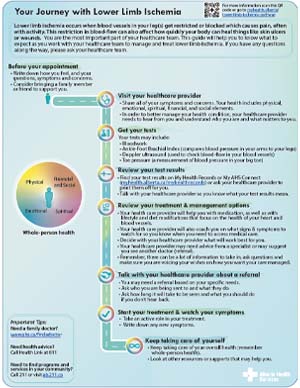Healthcare provider’s assessment
When you visit your healthcare provider for lower limb ischemia, they may:
- Ask about your pain level and what makes the pain worse. This is called a claudication assessment.
Claudication is the medical term for muscle pain in your legs that you feel with activity.
- Compare the blood pressure in your arms to the blood pressure in your legs. This is called the
ankle brachial index.
- Do a
doppler ultrasound to measure how much blood is flowing through the blood vessels in your legs and feet.
Things to watch for (symptoms of concern)
Make an appointment with your healthcare team if you have:
- pain that gets worse and doesn’t get better with rest
- changes to the colour of the skin of your feet
- cool or pale skin
- wounds that heal slowly or last a long time
Call your healthcare team
right away if you have:
- swelling, blistering, or wetness on your skin (this may be a serious infection)
- pain that gets worse quickly, sudden changes to the colour of your skin, numbness, or being unable to move your leg (these may be signs that a blood vessel is fully blocked)
Other things to tell your healthcare provider
You are the most important part of your healthcare team. Tell your healthcare provider about the impact the lower limb ischemia or pain is having on the things that are important to you like your job, hobbies and interests, and relationships.
Let your healthcare provider know what has worked well for you in the past. And tell them about things in your life that can impact how you are able to manage your health, like concerns with money, social support, or childhood experiences.
Remember to think about all parts of your health and wellness: physical, financial and social, spiritual, and emotional. This is called whole-person health.
Making the most of your appointment
If you don’t understand what your healthcare provider is telling you, let them know right away. Be open and honest. You might say:
- “It sounded like you said that I should… Did I understand that correctly?”
- “Can you show me a picture or model to help me understand?”
Learn more about
working with your healthcare team and making the
most of your appointment.

Lower Limb Ischemia Pathway
Download or print the full patient pathway (PDF) and summary (one-page PDF) to learn more about how to manage and treat lower limb ischemia.
Patient Pathway  Summary
Summary 
